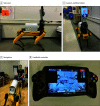Assessment of the Acceptability and Feasibility of Using Mobile Robotic Systems for Patient Evaluation
- PMID: 33662134
- PMCID: PMC8058534
- DOI: 10.1001/jamanetworkopen.2021.0667
Assessment of the Acceptability and Feasibility of Using Mobile Robotic Systems for Patient Evaluation
Abstract
Importance: Before the widespread implementation of robotic systems to provide patient care during the COVID-19 pandemic occurs, it is important to understand the acceptability of these systems among patients and the economic consequences associated with the adoption of robotics in health care settings.
Objective: To assess the acceptability and feasibility of using a mobile robotic system to facilitate health care tasks.
Design, setting, and participants: This study included 2 components: a national survey to examine the acceptability of using robotic systems to perform health care tasks in a hospital setting and a single-site cohort study of patient experiences and satisfaction with the use of a mobile robotic system to facilitate triage and telehealth tasks in the emergency department (ED). The national survey comprised individuals living in the US who participated in a sampling-based survey via an online analytic platform. Participants completed the national survey between August 18 and August 21, 2020. The single-site cohort study included patients living in the US who presented to the ED of a large urban academic hospital providing quaternary care in Boston, Massachusetts between April and August 2020. All data were analyzed from August to October 2020.
Exposures: Participants in the national survey completed an online survey to measure the acceptability of using a mobile robotic system to perform health care tasks (facilitating telehealth interviews, acquiring vital signs, obtaining nasal or oral swabs, placing an intravenous catheter, performing phlebotomy, and turning a patient in bed) in a hospital setting in the contexts of general interaction and interaction during the COVID-19 pandemic. Patients in the cohort study were exposed to a mobile robotic system, which was controlled by an ED clinician and used to facilitate a triage interview. After exposure, patients completed an assessment to measure their satisfaction with the robotic system.
Main outcomes and measures: Acceptability of the use of a mobile robotic system to facilitate health care tasks in a hospital setting (national survey) and feasibility and patient satisfaction regarding the use of a mobile robotic system in the ED (cohort study).
Results: For the national survey, 1154 participants completed all acceptability questions, representing a participation rate of 35%. After sample matching, a nationally representative sample of 1000 participants (mean [SD] age, 48.7 [17.0] years; 535 women [53.5%]) was included in the analysis. With regard to the usefulness of a robotic system to perform specific health care tasks, the response of "somewhat useful" was selected by 373 participants (37.3%) for facilitating telehealth interviews, 350 participants (35.0%) for acquiring vital signs, 307 participants (30.7%) for obtaining nasal or oral swabs, 228 participants (22.8%) for placing an intravenous catheter, 249 participants (24.9%) for performing phlebotomy, and 371 participants (37.1%) for turning a patient in bed. The response of "extremely useful" was selected by 287 participants (28.7%) for facilitating telehealth interviews, 413 participants (41.3%) for acquiring vital signs, 192 participants (19.2%) for obtaining nasal or oral swabs, 159 participants (15.9%) for placing an intravenous catheter, 167 participants (16.7%) for performing phlebotomy, and 371 participants (37.1%) for turning a patient in bed. In the context of the COVID-19 pandemic, the median number of individuals who perceived the application of robotic systems to be acceptable for completing telehealth interviews, obtaining nasal and oral swabs, placing an intravenous catheter, and performing phlebotomy increased. For the ED cohort study, 51 individuals were invited to participate, and 41 participants (80.4%) enrolled. One participant was unable to complete the study procedures because of a signaling malfunction in the robotic system. Forty patients (mean [SD] age, 45.8 [2.7] years; 29 women [72.5%]) completed the mobile robotic system-facilitated triage interview, and 37 patients (92.5%) reported that the interaction was satisfactory. A total of 33 participants (82.5%) reported that their experience of receiving an interview facilitated by a mobile robotic system was as satisfactory as receiving an in-person interview from a clinician.
Conclusions and relevance: In this study, a mobile robotic system was perceived to be acceptable for use in a broad set of health care tasks among survey respondents across the US. The use of a mobile robotic system enabled the facilitation of contactless triage interviews of patients in the ED and was considered acceptable among participants. Most patients in the ED rated the quality of mobile robotic system-facilitated interaction to be equivalent to in-person interaction with a clinician.
Conflict of interest statement
Figures


References
-
- Grossman J, Pierce A, Mody J, et al. Institution of a novel process for N95 respirator disinfection with vaporized hydrogen peroxide in the setting of the COVID-19 pandemic at a large academic medical center. J Am Coll Surg. 2020;231(2):275-280. doi: 10.1016/j.jamcollsurg.2020.04.029 - DOI - PMC - PubMed
Publication types
MeSH terms
Grants and funding
LinkOut - more resources
Full Text Sources
Other Literature Sources
Medical
Miscellaneous

